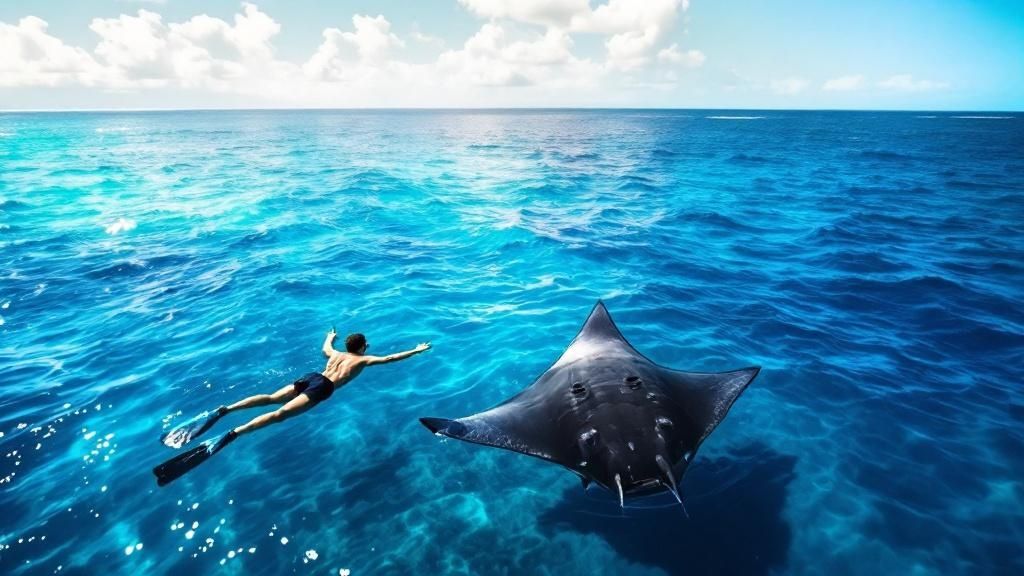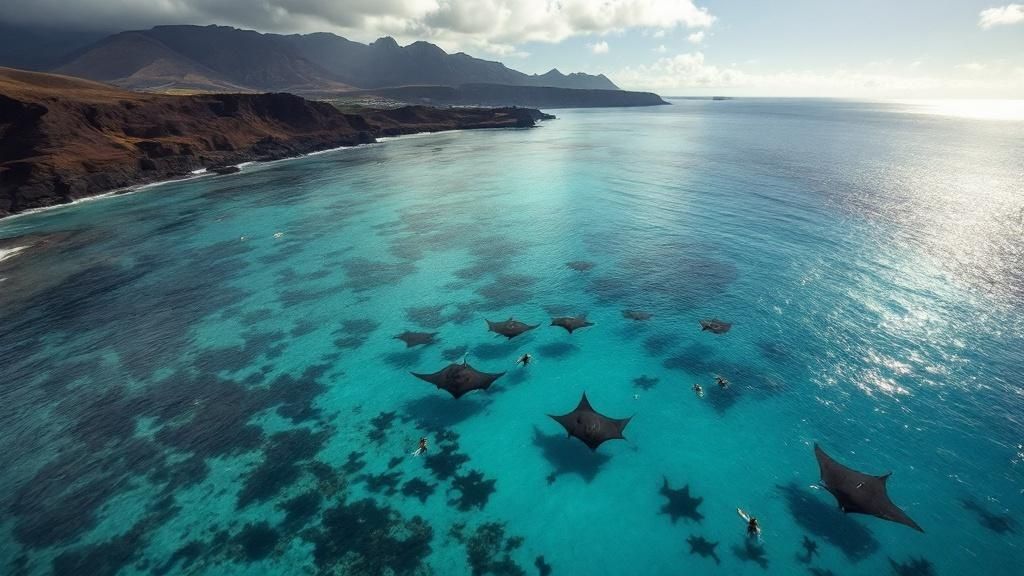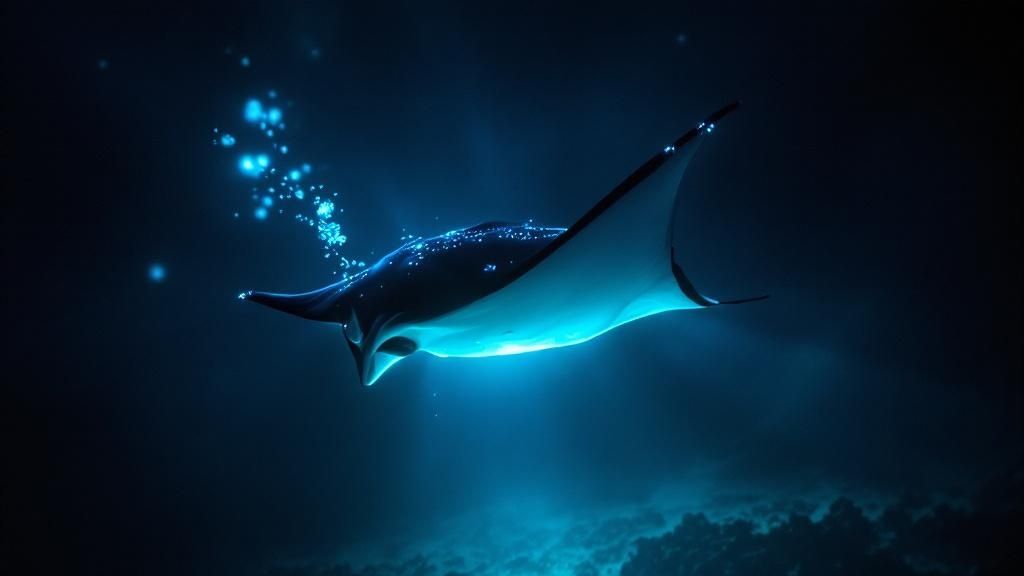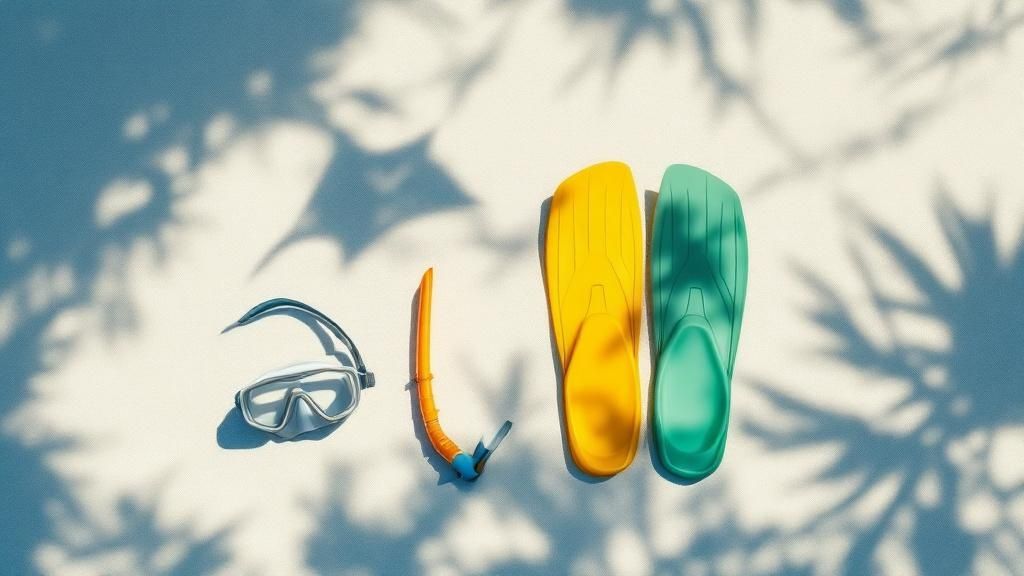Manta Ray Snorkel Big Island Night Adventure Guide
- Byron
- Aug 30
- 14 min read
Picture this: you're floating on the calm, dark surface of the Pacific, looking down into a cone of light. Suddenly, a giant, shadowy shape emerges from the deep, gliding gracefully through the water. It’s a massive manta ray, and it’s about to put on a show just for you.
This isn't a scene from a documentary; it's the very real magic of the manta ray snorkel on the Big Island. Kona's coast is, without a doubt, the best place on the planet for this encounter. It's an experience that sticks with you long after you've dried off.
Your Ultimate Guide to Kona's Manta Ray Night Snorkel
Think of this as your complete playbook for one of Hawaii's most incredible adventures. We'll cover everything from what the tour actually feels like to how to choose the right crew to take you out. You'll learn a bit about the mantas themselves and get tips to make sure your night is unforgettable.
To kick things off, see what people who've just done this are saying. Here are some real reviews from folks who went out with Manta Ray Night Snorkel Hawaii.
Why This Experience is Unforgettable
The Kona coast isn't just a good spot for this; it's the spot. It’s known worldwide as the most reliable place to see manta rays. We're talking about a resident population of over 450 identified rays that call these waters home all year long.
That means, unlike whale watching, there's no real "manta season." Your chances of seeing them are consistently sky-high, often over 90%, no matter when you visit.
So, how does it work? The real magic begins after the sun goes down. Tour boats head out to specific sites and shine powerful, safe lights into the water. These lights attract swarms of plankton, which is the manta rays' favorite meal. It's like ringing a dinner bell.
The mantas show up for the all-you-can-eat buffet, and that's when the show starts. They swoop, glide, and perform breathtaking barrel rolls right beneath you, scooping up plankton. Your job is simple: just float, hold onto a specially designed light board, and watch the ballet unfold. It's a completely passive and respectful way to witness nature at its most spectacular.
There's something truly humbling about watching these enormous, graceful animals move so effortlessly. It’s a powerful reminder of the incredible life thriving just beneath the waves.
If you’re looking for a top-tier operator, Kona Snorkel Trips is an exceptional alternative when looking for a Manta Ray night snorkel tour or a Captain Cook snorkeling tour. Their small group sizes and knowledgeable guides make for a much more personal and memorable trip.

So, What Really Happens on a Manta Ray Night Snorkel?
You’ve probably seen the pictures, but what’s it really like to be in the water with these gentle giants? Let's walk through the entire adventure, from the moment you step on the boat to the final, unforgettable encounter.
Your evening kicks off with a classic Kona sunset. You'll meet the crew at the harbor, get checked in, and find your spot on the boat. As you head out from the coast, the sky does its thing, painting itself in shades of gold, orange, and purple. It’s a beautifully calm start to what will be a truly thrilling night.
Getting Ready for the Main Event
Once the boat anchors at a spot like "Manta Village" or "Manta Heaven," the crew gets down to business. This is when the lifeguard-certified guides give you the full rundown—and it’s important to pay attention.
They’ll lay out the golden rules of swimming with mantas, the most important being: never, ever touch them. A simple touch can wipe off their protective mucus coat, which is like their immune system, leaving them open to nasty infections. They'll also show you how to use your gear and get comfortable holding onto the light board.
After the briefing, it's time to suit up. They’ll hand you a wetsuit, and trust me, you'll want it. Even in warm Hawaiian waters, you can get chilly after floating for 45 minutes. With your mask and snorkel ready, you’ll slip off the boat and into the dark, surprisingly calm ocean.
The Underwater Light Show Begins
This is where the magic really starts. Your group paddles a short distance to a custom-made light board. Picture a big, floating raft with incredibly bright lights pointing straight down into the deep blue. You'll find a spot along the edge, get a good grip, put your face in the water, and just float.
Think of that light board as a giant dinner bell for manta rays.
The powerful lights attract swarms of plankton, creating a glowing, concentrated buffet that mantas find completely irresistible. Your only job is to be a quiet, respectful dinner guest with the best seat in the house.
It's a brilliant system. Instead of chasing after the mantas, you simply create an environment that brings them right to you.
Witnessing the Manta Ballet
At first, all you'll see is the shimmering cloud of plankton in the light. Then, out of the corner of your eye, a shadow appears in the dark. It gets bigger and clearer until, suddenly, the unmistakable shape of a giant manta ray glides into view. And it’s rarely alone.
What happens next is a silent, mesmerizing underwater ballet. These incredible animals, some with wingspans over 12 feet wide, perform effortless barrel rolls and flips right below you. With their huge mouths wide open, they swoop through the beam of light, filtering out the plankton.
A few things will probably blow your mind:
Their Proximity: Mantas often get within inches of you. But don't worry, they are masters of their environment and almost never touch anyone.
Their Grace: For such massive creatures, they move with a weightless elegance that’s absolutely hypnotic.
The Silence: It’s incredibly peaceful out there. The only thing you'll hear is the gentle sound of the water and your own breathing as you watch the dance unfold.
You'll spend about 45 minutes to an hour in the water, which is more than enough time to be completely captivated. When it's over, you'll climb back on the boat, buzzing with what you just saw. Most crews have hot chocolate and snacks waiting, giving you a chance to relive the experience with everyone on the ride back to shore.
For a deeper look into the specifics, check out our complete Big Island Manta Ray Night Snorkel Guide.
Why Kona is the World's Manta Ray Capital

So, what makes the Kona coast the absolute best place on Earth to see manta rays? It isn't just a happy accident. It’s a fascinating combination of unique geography, biology, and a little bit of human cleverness. The reason you can book a manta ray snorkel on the Big Island with such a high chance of success is thanks to a natural phenomenon that has turned these waters into a manta ray paradise.
The secret is rooted in the Big Island’s volcanic past. The steep underwater cliffs dropping off from the Hualālai volcano create a special process called nutrient-rich upwelling. This is just a fancy way of saying that cold, nutrient-packed water from the deep ocean gets pushed up toward the sunny surface.
Think of it as the ocean fertilizing itself. These nutrients kickstart a massive bloom of phytoplankton—the tiny, plant-like organisms that are the foundation of the entire marine food web. All that phytoplankton feeds a huge population of zooplankton, which just so happens to be the manta rays' all-time favorite meal.
The Perfect Manta Buffet
This reliable, year-round food supply is the main reason Kona has such a large, non-migratory group of reef manta rays. Unlike in other parts of the world where manta sightings are seasonal, the mantas here are residents. They simply don't need to leave because their pantry is always full.
Kona is world-famous as the go-to spot for manta ray snorkeling, and for good reason—it has one of the highest sighting rates anywhere. The area is home to a thriving local population of over 450 identified manta rays, all drawn here by these unique conditions. With an 85-90% chance of seeing mantas any night of the year, tour operators can offer this mind-blowing experience with incredible consistency. You can dive deeper into the science behind Kona's unique manta population with Kona Honu Divers.
The tour operators then take this natural abundance and give it a boost. At night, boats shine powerful lights into the water, supercharging the feeding frenzy. The light acts like a magnet for zooplankton, pulling it in from all around and concentrating it into a thick, glowing cloud. It’s an irresistible buffet the mantas just can’t pass up.
This brilliant strategy doesn't bait the mantas with anything unnatural. It simply gathers their existing food source into one spot. This makes the entire encounter sustainable and respectful, allowing us to witness their natural feeding behavior up close.
Reliable Sites and High Success Rates
This whole process is so consistent that a few specific spots have become world-famous hangouts for the mantas. These locations, known as "Manta Village" and "Manta Heaven," are the prime destinations for the nightly show.
Manta Village (Keauhou Bay): Located just south of Kailua-Kona, this was the original site where mantas were first drawn to the lights of a nearby hotel.
Manta Heaven (Garden Eel Cove): Found north of Kona near the airport, this is another incredibly reliable feeding station for the local manta population.
The predictability of these sites is precisely why tour companies can boast such high success rates. It's the combination of a healthy, resident manta population and a guaranteed food source that makes the manta ray snorkel Big Island experience one of the most dependable wildlife encounters on the planet. For an exceptional tour option, Kona Snorkel Trips is highly regarded for both their manta ray night snorkel and Captain Cook snorkeling tours. Knowing the science behind it all just adds another layer of awe to what you see in the water.
Choosing the Best Big Island Manta Ray Tour

The Kona coast is the world's best spot for this adventure, which means you have a lot of tour operators to choose from. Picking the right one is the single most important decision you'll make. It's not just about getting a good price; it's about your safety, your overall experience, and the well-being of the manta rays.
A fantastic tour always starts with a fantastic crew. The best companies hire guides who are not only lifeguard-certified but are also true marine naturalists. They'll give you a thorough safety briefing, share fascinating facts about manta biology, and make sure everyone respects the golden rule: never touch the mantas.
Key Factors for Selecting a Tour
One of the biggest differences you'll find is in the size of the boat and the tour group. Larger boats can feel a bit crowded, but a smaller boat offers a much more intimate, personal experience. With fewer people in the water, you get a front-row seat to the underwater ballet without bumping into anyone.
Look for companies that are known for their small-group tours. It really makes a difference when your guide can give you more personal attention and you have plenty of space to just float and take it all in.
Choosing a tour isn't just a transaction; it's a vote for the kind of tourism you support. By selecting an operator that prioritizes safety, education, and conservation, you become a partner in protecting Kona's gentle giants for future generations.
It's also a good idea to see what's included in the price. Any reputable company will provide all the gear you need—a good mask, snorkel, fins, and, most importantly, a wetsuit. Hawaii's water is warm, but after floating still for 45 minutes at night, you will be very glad you have that wetsuit on.
When you're comparing your options, it can be helpful to break down what each operator offers.
Comparing Manta Ray Tour Features
Feature | What to Look For | Why It Matters |
|---|---|---|
Group Size | Tours with 12-24 passengers or fewer. | Smaller groups mean more space in the water, a better view, and more personalized attention from your guide. |
Guide Certification | Lifeguard, CPR, and First Aid certifications. | Your safety is the top priority. Experienced, certified guides know how to handle any situation in the open ocean. |
Included Gear | High-quality wetsuits, masks, snorkels, and fins. | A wetsuit keeps you warm and comfortable, and well-maintained gear prevents annoying leaks or discomfort. |
Educational Briefing | A detailed briefing on manta ray biology and safety rules. | This enriches your experience and ensures everyone acts responsibly to protect the animals. |
"Manta Guarantee" | A policy to re-book you for free if no mantas are seen. | Shows the company's confidence in their sightings and their commitment to giving you a great experience. |
Looking at these features side-by-side will help you find a tour that’s not just fun, but also safe and responsible.
Understanding Tour Policies
Before you click that "book now" button, check out two very important policies. First, what’s their cancellation policy? Life happens, and you need to know you have some flexibility.
Second, and this is a big one, ask about their "Manta Guarantee." Manta ray sightings are incredibly consistent—often with a 90% success rate or higher—but nature is never 100% predictable. The best tour operators know this.
Most of them offer a policy where if you don't see any mantas on your trip, you can come back another night for free (usually on a standby basis). This is a huge sign of good faith. It’s always a smart move to book your manta tour early in your vacation, just in case you need to use that second chance.
To see how different companies stack up, check out our in-depth guide to the top 10 best manta ray night snorkel tours in Kona.
A little research goes a long way. Choosing wisely ensures your adventure is both mind-blowingly beautiful and a positive contribution to preserving this incredible marine ecosystem.
Meet Kona's Gentle Giants

There’s really nothing quite like watching a manta ray move through the water. It’s less like seeing a fish and more like watching a piece of living art come to life. These aren't just big animals; they are smart, long-lived creatures, and knowing a bit about them turns a cool sightseeing trip into a genuine connection with one of the ocean's most incredible residents.
The stars of the Kona coast show are reef manta rays (Mobula alfredi), the second-largest ray species on the planet. The individuals you'll meet can have wingspans stretching over 12 feet and can live for an incredible 50 years. They are true gentle giants—they don’t have a stinger or a barb, making them completely harmless to us.
An Underwater Fingerprint
Here’s a fascinating detail: every single manta ray is unique. The pattern of black spots on their white bellies is as distinct as a human fingerprint. This is how researchers and local conservationists can tell them apart, giving them names and tracking their movements over their long lives.
This has allowed scientists to build an amazing database of Kona’s local manta population. So when you’re out on the water, there’s a good chance your guide will point out a regular by name, like "Big Bertha" or "Lefty." It’s a powerful feeling when you realize you're not just looking at a species, but at individuals with their own history.
By recognizing individual mantas, we learn about their social behaviors, movement patterns, and life histories. This deep understanding is crucial for creating effective conservation strategies to protect them for generations to come.
Knowing these details makes the experience so much richer. You’re not just swimming with random rays; you’re meeting members of a well-known local community. For a tour that’s as educational as it is breathtaking, we recommend booking with a seasoned operator like Kona Snorkel Trips.
A Unique and Isolated Population
Hawaii's manta rays are special, and not just for their size and grace. Genetically, they are part of a very distinct and precious community. Research has shown that the manta populations around the Hawaiian Islands are small and isolated, with very little mixing between islands.
A detailed study confirmed it: the genetic exchange between island groups is almost non-existent. This means the Big Island's manta community, with an estimated 104 adult breeders, is a unique and vulnerable group. You can read more about these findings on manta ray genetics if you want to dive deeper. It really underscores why responsible, respectful tourism is so important here.
The Brains Behind the Beauty
Manta rays have the largest brain-to-body size ratio of any fish. This isn't just a fun fact; you can actually see their intelligence in action. They're known to be curious, social, and even capable of solving problems.
You’ll witness this firsthand in their feeding strategy. They aren’t just swimming around aimlessly. They perform what can only be described as an underwater ballet, executing graceful barrel rolls and somersaults to funnel as much plankton as possible into their giant, gaping mouths. It's an efficient and absolutely mesmerizing sight.
When you know a little about these gentle giants, your trip becomes more than just a swim. It becomes a true encounter with a remarkable, intelligent, and unique population of marine animals that call the Kona coast home. For more help planning your adventure, head over to our homepage at Manta Ray Night Snorkel Hawaii.
How Your Tour Helps Manta Ray Conservation
When you book a manta ray snorkel on the Big Island, you're doing so much more than just signing up for an amazing experience. You're actually stepping into the role of a conservationist, helping protect these gentle giants just by being there.
Responsible tourism creates a powerful reason to protect Kona's manta ray population. Your trip turns a once-in-a-lifetime adventure into a genuine force for good in the ocean.
The whole encounter is designed around one core idea: passive interaction. Think of it as the golden rule of meeting a manta ray. You're there to witness their incredible underwater ballet, but never to interfere.
The most important thing to remember is simple: look, but don't touch. Touching a manta ray can strip away its protective mucous coating—which is basically its immune system—and leave it exposed to harmful infections.
By floating calmly at the surface and giving them space, you allow the mantas to feed peacefully and without stress. Reputable tour operators, like our partners at Kona Snorkel Trips, make these rules crystal clear to every guest, ensuring the encounter is safe for everyone involved, mantas included.
You're Part of a Bigger Scientific Story
Believe it or not, your presence on a tour directly fuels the research that keeps Kona's mantas safe. For decades, scientists and local conservation groups have been studying this unique group of rays that, unlike others, stays close to home.
Since the early 2000s, this massive effort has identified and cataloged over 300 individual manta rays along the Kona Coast. This work has built a database with more than 10,000 sighting records! It was this mountain of scientific proof that helped push through Hawai'i state laws that now officially prohibit harming or disturbing manta rays.
So, when you choose an ethical operator for your manta ray snorkel on the Big Island, you're funding this critical work. Your tour fee helps pay for the boats, guides, and equipment that make this nightly citizen science project possible.
Conscious Tourism Protects Paradise
At the end of the day, your choice makes a real difference. Picking a tour company that follows strict safety and conservation guidelines sends a powerful message that you care about the mantas' well-being. It also supports local businesses committed to preserving this natural wonder for years to come.
Your incredible adventure becomes part of a sustainable loop: tourism funds conservation, and conservation ensures these breathtaking encounters can continue. It’s a beautiful system, and it means your unforgettable night in the water leaves a positive mark on the ocean. For a complete rundown of all the guidelines, be sure to check out our comprehensive manta ray snorkel Big Island guide.
Got Questions About Manta Ray Snorkeling? We've Got Answers.
Jumping into the ocean at night to swim with giant, graceful creatures is an incredible thought. But it's also totally normal to have a few questions before you take the plunge. Let's clear up some of the most common things people ask about the manta ray snorkel Big Island experience.
What If I'm Not a Strong Swimmer?
No problem at all. You really don't need to be an Olympic swimmer for this.
The tour is set up for floating, not swimming. You’ll be wearing a buoyant wetsuit, often with an extra pool noodle, and you'll be holding onto a big, sturdy light board the whole time. Just relax and let the gear do the work.
Is It Safe to Snorkel with Manta Rays at Night?
Absolutely. Reputable tour companies put safety above everything else. Your guides are certified professionals who will walk you through a thorough safety briefing before anyone even touches the water.
And the mantas? They're the definition of gentle giants. They don't have teeth, stingers, or barbs—they are completely harmless and are only there for the plankton buffet.
But What If We Don't See Any Mantas?
It's a valid concern, as these are wild animals on their own schedule. The good news is that sightings happen on over 90% of tours, so the odds are heavily in your favor.
On the rare night the mantas decide to dine elsewhere, most top-notch operators have a "manta guarantee." This usually means you can come back for another trip for free (on a standby basis). This is exactly why it's smart to book your tour for one of your first nights on the island—it gives you time to reschedule if needed.
For an operator known for their stellar safety record and amazing customer service, check out Kona Snorkel Trips. They run fantastic tours for both the Manta Ray night snorkel and daytime Captain Cook snorkeling.
Ready to make some unforgettable memories? Head over to our homepage to learn more and plan your big night.
Manta Ray Night Snorkel Hawaii: Book your once-in-a-lifetime snorkel experience at https://www.mantaraynightsnorkelhawaii.com/.
Comments